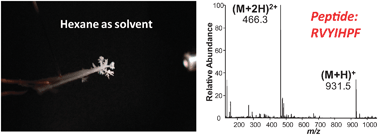US analytical scientists have used non-polar solvents for the paper spray ionisation of polar compounds.
Polar compounds are normally ionised in mass spectrometry using a desorption ionisation method, such as MALDI, or from solution in a polar solvent using electrospray ionisation (ESI). However, ESI does not usually tolerate non-polar solvents and, as many reactions or purifications of compounds occur in non-polar solvents, this can present some difficulties.
Graham Cooks and co-workers from Purdue University have extended the scope of the recently developed paper spray ionisation technique to allow the use of non-polar solvents. When a low voltage is exposed to a triangle of paper wetted with a solvent such as hexane or toluene, droplets of that solvent are produced. Polar compounds that are deposited on the paper are transported by the non-polar solvent compounds despite being sparingly soluble in them.

This technique can be applied to biological compounds, such as nucleotides, phospholipids and peptides, and avoids a typical problem associated with ESI where there capillary may clog when a non-ideal solvent is used. Furthermore, compounds may be analysed simply by ionising spots separated via TLC.
If you want to find out more then download the ChemComm article today. For wider look at analytical chemistry, why not check out these papers in our sister journal Chemical Science?










